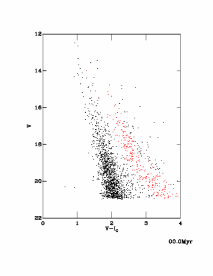Cepheus OB3
Paper | Table | Catalogue | Link | |
| Bell et al (2013) | 9 | Full ugriz catalogue | FITS | gzipped ASCII |
| 10 | Members | FITS | gzipped ASCII | |
| Novarflag | FITS | gzipped ASCII | ||
| Littlefair et al (2010) | Hα photometry | ASCII | ||
| Periodic objects | ASCII | |||
| Mayne et al (2007) | 13 | BVI photometric catalogue | ASCII | |
| 14 | X-ray sources from Naylor and Fabian (1999) | ASCII | ||
| 15 | Spectroscopic members from Pozzo et al (2003) | ASCII | ||
| 16 | Periodic variability members from Littlefair et al (2010). | ASCII | ||
| 17 | Hα sources from Ogura et al. (2002) | ASCII | ||
| 18 | X-ray sources from Getman et al (2006) | ASCII | ||
| Pozzo et al (2003) | Full UBVI catalogue | ASCII |
 Bell et al (2013)
Bell et al (2013) Littlefair et al. (2010)
Mayne et al. (2007)
Burningham et al. (2005)
Pozzo et al. (2003)
Pozzo (2001)
In Naylor & Fabian (1999) we discovered the low-mass stars in Cep OB3b using ROSAT X-ray observations. Our catalogue of X-ray sources is now available via our catalogue server, which has the advantage it will give you finding charts as well. Note that the first "colour" is actually the radius of the X-ray error circle (7" for the HRI, 14" for the PSPC).
In Pozzo et al (2003) we describe the discovery of the pre-main-sequence in this association. Our photometric catalogue is now available, along with a list of the improvements made since the paper was published. You may also like to try this animation. We've simply taken the photometry of one of our fields, placed the PMS stars (shown in red) on PMS tracks, and then evolved the system forward 20 Myr. Notice how a very broad ``age spread'' tightens up as the association gets older.
We also present a colour-magnitude diagram for this association in Ben Burningham's paper on variability in pre-main-sequences (also available in its PPV and thesis versions) and in a preliminary version of Stuart Littlefair's rotational study of this association, (also presented at PPV).
This cluster is also studied in Mayne et al (2007), an empirical isochrone was generated using a sequence of selected members. The resulting isochrone is used with a relative age ladder to assign an age, though this age has now been superceded by that in Littlefair et al (2010). The catalogues from this paper were revised in October 2013 to remove the values of B-V, since no B -band data were taken for this cluster.
In Littlefair et al (2010) we determine rotational periods for 475 stars in the association. We find similar correlations with mass and accretion as have been found in other star-forming regions, but the correlation with mass is weaker than expected. Furthermore, the mean rotation rate of the low-mass stars is much slower than in the similar-aged NGC2362, pointing to a connection between and environment and the destruction of accretion discs. Here we present our Hα photometry, and the magnitudes, colours and rotation periods for objects for which we have determined periods. Both these tables use the object IDs, magnitudes and V-I colours from Mayne et al (2007).